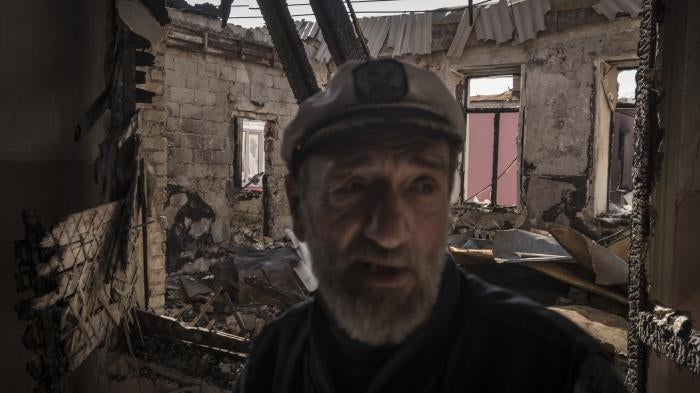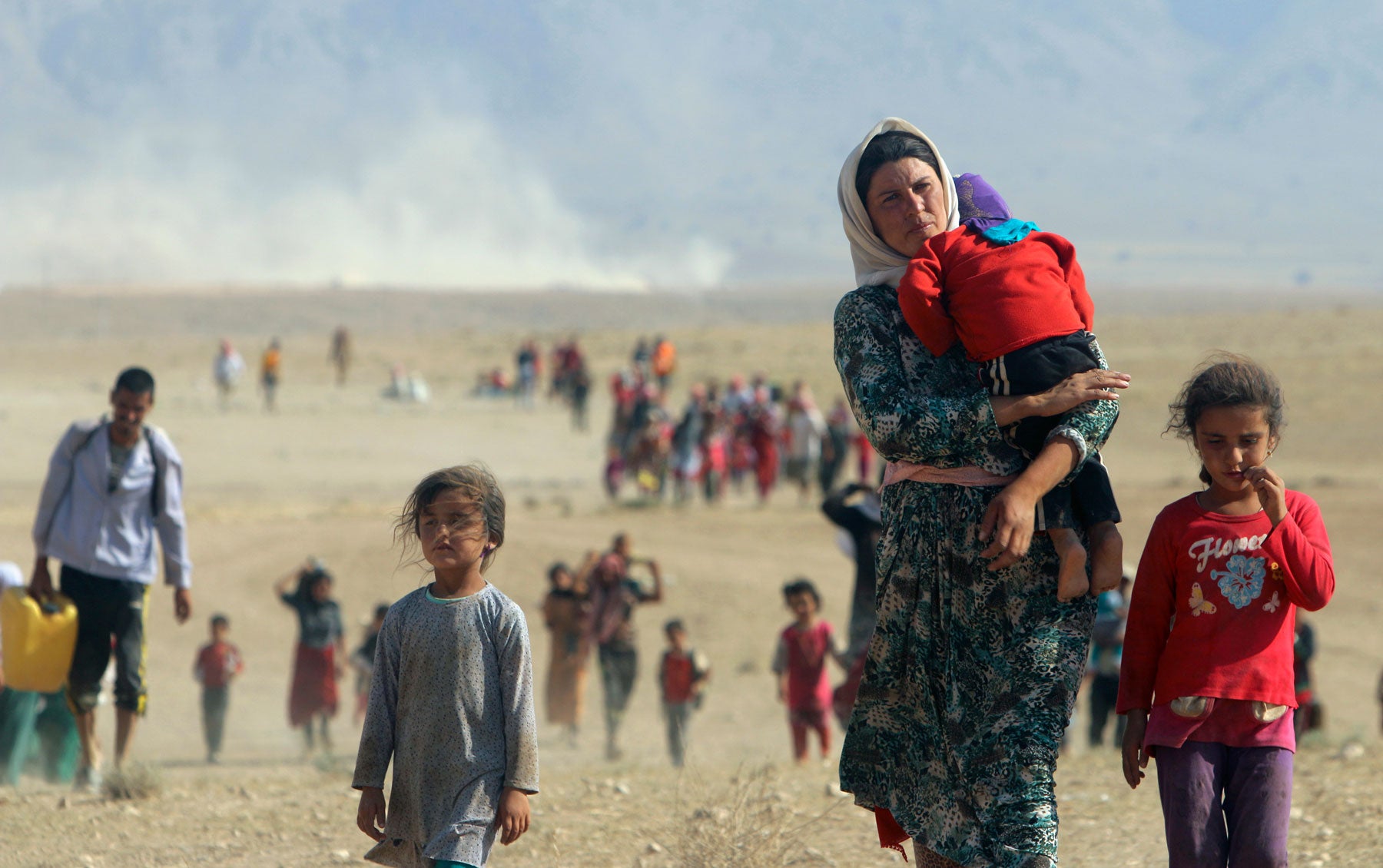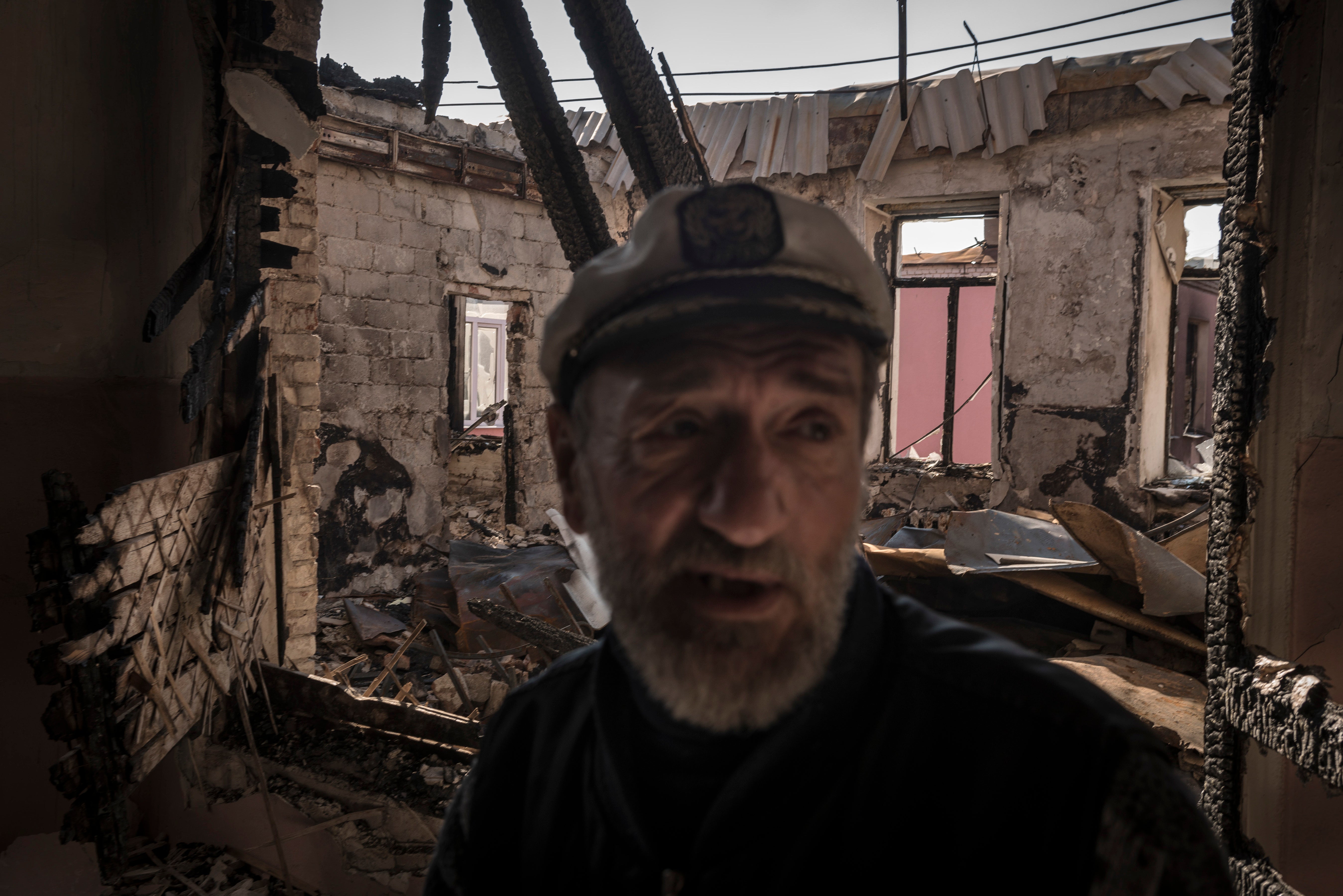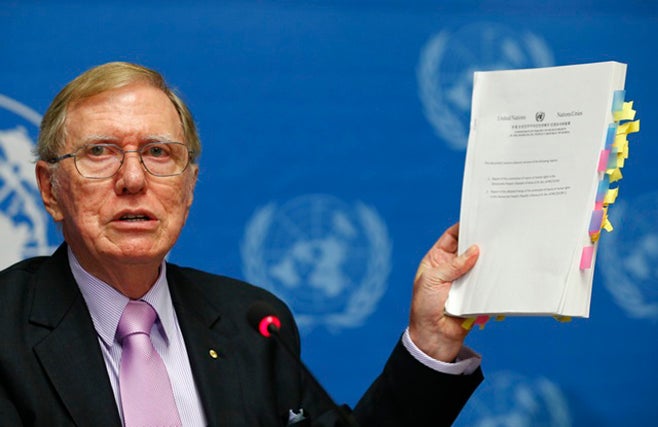Late in the evening of September 1, 2014, an Iraqi air force plane dropped a bomb on a school in Al-Alam near Tikrit in northern Iraq, which had recently fallen under the control of the extremist group Islamic State (also known as ISIS). Dozens of displaced families were sheltering in the building at the time. The immense explosion and flying shrapnel killed at least 31 civilians, including 24 children, and wounded 41 others. One survivor who spoke to Human Rights Watch lost his wife, two sons, a daughter, a sister, and a nephew in the blast. Five members of his family were also wounded, including his son Yazin, just six months old.
Modern and not-so-modern armies rely on explosive weapons—including aircraft bombs, mortars, artillery, rockets, and even ballistic missiles—to conduct military operations, not ubiquitous assault rifles and machine guns. As a result, when civilians are killed or wounded in fighting in populated areas, it is usually these weapons that inflict the harm.
In 2014 alone, Human Rights Watch documented the use of explosive weapons in populated areas in violation of international humanitarian law (the laws of war) in at least 12 countries, including Syria, Iraq, Israel/Gaza, Ukraine, Libya, Pakistan, Afghanistan, Sudan, Nigeria, Somalia, Thailand, and Colombia. Such unlawful attacks were typically indiscriminate because they did not distinguish between the military target and civilians, or were disproportionate because the anticipated civilian loss from the attack exceeded the expected military gain.
Ranging from cheap and easy to produce to complex and expensive, explosive weapons are often deadly to anyone nearby. According to Action on Armed Violence, a United Kingdom-based nongovernmental organization, explosive weapons maimed and killed almost 38,000 people in 2013—82 percent of them civilians. Not surprisingly, when more civilians are
present, the percentage of civilian casualties jumps; explosive weapon use in populated areas resulted in civilian dead and injured reaching 93 percent in the same period. In Syria, explosive weapons have been responsible for more than 50 percent of the civilian deaths (about 40,000 of more than 75,000) documented by the Violations Documentation Center, a Syrian-based monitoring group, since conflict erupted there in 2011.
Not all uses of explosive weapons in populated areas violate international humanitarian law. But the increase in urban warfare and rapidly mounting civilian casualties around the world scream for urgent action. For several years, international momentum has been building to curtail the use of explosive weapons in populated areas, including halting the use of those with wide area effects. Doing so would help save lives, alleviate civilian suffering, and reduce destruction of civilian infrastructure, which would facilitate post-conflict recovery. It could be the single most crucial step that nations take to protect civilians from the horrors of war.
***
When explosive weapons detonate, they send a powerful and destructive blast wave that travels faster than the speed of sound. Often, however, the most lethal effects are caused by flying fragments of casing—shrapnel—which can have a long reach. The Syrian government’s OFAB 250-270 aircraft bomb, for example, can inflict damage and injuries within a 155-meter radius from where it strikes. The casing can also be designed to shatter into sharp pieces of metal that can penetrate the body and rip internal organs, causing life-threatening injuries.
The wide area effect of some explosive weapons is a key reason why they kill and injure so many civilians. A weapon that can injure people in a radius of dozens or hundreds of meters of its strike will almost certainly kill or wound civilians when used in populated areas. Many explosive weapons are also unguided or are used without spotters, which means that they cannot be targeted precisely, posing additional risk to civilians. A doctor at a morgue in eastern Ukraine told Human Rights Watch that 99 percent of the civilian war victims it had received had died of fragmentation injuries caused by explosive weapons.
In Syria, where the use of explosive weapons in populated areas has been particularly extensive, the government has used a broad range of such weapons since 2011, including mortars, artillery, rockets, fuel-air explosives, and ballistic missiles. Since late 2013, the government has also increasingly used “barrel bombs.” Built locally from oil drums, gas cylinders, and water tanks, they are packed with a deadly cargo of high explosives, oil, chemicals, and scrap metal to enhance fragmentation on impact.
In 2014, Human Rights Watch documented hundreds of irregularly shaped blast craters in Aleppo caused by such bombs, and recorded dozens of injuries and fatalities, including that of Noura al-Abdu, 13, who was decapitated in Hraytan, northwest of Aleppo, in a December 2013 barrel bomb attack that also severed the leg of a 9-year-old girl as she sought shelter from a helicopter overhead.
Armed groups opposed to the Syrian government have also fired mortar and artillery shells and launched rockets into populated government-controlled areas, and their powerful car bombs have killed hundreds of civilians. A twin bomb attack targeting a school in Homs, Syria on October 1 reportedly killed dozens of children and several adults. On April 29, two mortar shells also struck the Badr el-Din Hussaini educational complex in the al-Shaghour neighborhood of Damascus, a pro-government area, killing 17 children and at least two parents and injuring 50 others.
In Iraq, ISIS has earned a reputation for limitless cruelty by shooting and beheading hundreds of non-combatants in cold blood. But they have also fired mortar shells into populated areas, killing and maiming civilians, and used car bomb attacks across the country that have killed hundreds of people and likely amount to crimes against humanity. The government’s response to ISIS has included the use of barrel bombs and a string of indiscriminate attacks.
In Gaza, Israeli forces fired tens of thousands of explosive weapons into populated areas where Hamas was deployed during a seven-week-long war in July and August. Hamas itself fired thousands of rockets and mortars toward Israeli population centers. Israeli attacks killed more than 2,100 Palestinians, including at least 1,486 civilians, according to the United Nations. Daily casualty reports from local human rights organizations in Gaza show that nearly all the deaths were due to explosive weapons.
In Ukraine, government forces have fired artillery, multiple-launch Grad rockets, and other explosive weapons into populated areas where pro-Russia rebel forces were deployed, killing dozens and injuring many more. The pro-Russia forces have used the same kind of explosive weapons against government forces, also killing and injuring civilians.
In Sudan, persistent government bombing of populated areas in the Nuba Mountains (Southern Kordofan) and Blue Nile has killed and maimed hundreds of civilians and damaged humanitarian aid structures since the conflict started in 2011. A surge in bombing in May and June of 2014 damaged humanitarian aid facilities and forced the humanitarian organization Médecins Sans Frontières (Doctors Without Borders) to withdraw.
Using explosive weapons in populated areas not only causes civilian casualties, but also destroys civilian infrastructure such as schools, hospitals, water pipes, and electrical power grids, prolonging the impact of armed conflict for civilians.
For example, when government and rebel forces were firing unguided rockets, artillery and other explosive weapons at each other in Luhansk, eastern Ukraine, tens of thousands of people trapped in the city were left without running water and electricity for weeks. When a Human Rights Watch researcher visited in late August, hundreds of people were braving regular bombardment to line up for hours at dawn for water and food at distribution points across the city, carrying empty bottles and containers.
Israeli explosive weapons destroyed or damaged more than 15,000 buildings in Gaza during the summer’s conflict, according to satellite imagery analysis conducted by the United Nations Institute for Training and Research. Schools were particularly affected; 228 were damaged, according to a UN special rapporteur, severely impacting children’s education. When the school year began in September, around 90 percent of Gaza’s schools were running on a double shift, with students attending for just four hours each day.
In northern Syria, government air strikes, some seemingly deliberate, have damaged and destroyed hospitals, leaving the medical system in shambles. Physicians for Human Rights, a group that documents the plight of medical personnel, has recorded nearly 200 attacks on hospitals in Syria since the start of the conflict. The few medical resources that are available are insufficient to cope with war-related injuries; maternal health, vaccinations, burns, and chronic diseases are neglected. In northern and eastern Syria, the collapse of the medical system contributed to the outbreak of polio, a disease not seen in the country since 1999.
The use of explosive weapons in populated areas is also one of the main reasons for displacement of civilians. Most people we interviewed in refugee camps in Turkey, Jordan, and Lebanon said they had fled Syria because of the government’s constant bombardment of areas held by non-state armed groups. People fleeing Luhansk in Ukraine said the same.
International law prohibits the use of certain explosive weapons, most notably antipersonnel landmines and cluster munitions. But for the most part, the legality of explosive weapon use is decided on a case-by-case basis by general provisions in international humanitarian law—such as the obligation to conduct attacks using weapons in a matter that can distinguish between civilians and combatants or other military objectives.
This piecemeal analysis does not lend itself to a categorical finding regarding a broad category of weapons (e.g. explosive weapons) in a general type of setting (e.g. populated areas). As a result, it cannot set a clear boundary on this issue.
So what can be done?
A legally binding ban on the use of all explosive weapons in populated areas would not be politically feasible, but it is possible to set standards that would significantly raise the bar. Human Rights Watch is a founding member of the International Network on Explosive Weapons (INEW), a global coalition of NGOs established in 2011 to work to prevent harm from the use of explosive weapons in populated areas. INEW calls on governments to “develop stronger international standards, including certain prohibitions and restrictions on the use of explosive weapons in populated areas.”
Building these standards takes time. But states and other actors should now acknowledge the problem in international discussions and review national policies that outline what weapons are appropriate for use in populated areas and under what circumstances. They should seek to develop a common position that aims to further limit the use of explosive weapons in populated areas. In particular, they should agree to halt altogether the use of explosive weapons with wide area effects in populated areas. As a matter of policy, military commanders should not order the use of explosive weapons with wide area effects in populated areas due to the foreseeable harm to civilians.
Emphasizing explosive weapons with wide area effects is crucial because they have caused the most civilian harm. The concept of wide area effect will need to be more precisely defined, but it should include heavy weapons that produce a wide blast and/or fragmentation radius (like large aircraft bombs); weapons with multiple munitions or explosive warheads that cover a large area (like Grads and other multiple launch rocket systems); and weapons that are so inaccurate that they cannot be effectively targeted (like barrel bombs).
Other measures could be considered that could go beyond the minimum requirements of international humanitarian law, apart from halting the use of explosive weapons with wide area effects in populated areas. Possibilities that have been discussed include restricting the use of indirect fire weapons or unguided weapons in populated areas and committing to using the least destructive force to achieve a military advantage. States could articulate best practices related to doctrine, operational policies, planning directives, rules of engagement, and other such guidance.
Despite the increasing use of explosive weapons in populated areas in 2014, the year also saw significant international efforts to address this issue—and momentum is likely to grow. The UN secretary-general, several UN agencies (notably the Office for the Coordination of Humanitarian Affairs, or OCHA), and the International Committee of the Red Cross (ICRC) have all called on states to refrain from using explosive weapons with wide area effect in populated areas. In March, the ICRC held a meeting to consider how to strengthen the protection of civilians from explosive weapons used in populated areas. In June, Norway hosted an informal experts meeting with OCHA with the same purpose. Austria has announced that it will host a follow-up meeting in 2015.
A sustained international process to address the use of explosive weapons in populated areas is getting underway. Views appear to be coalescing around two notions: that the most feasible outcome of international discussions is likely to be a politically binding commitment—such as a joint declaration of guidelines—rather than a new legal instrument; and that there should be a focus on explosive weapons with wide area effects.
Some government and military experts have expressed concern about the growing effort to curb explosive weapon use in populated areas based on two arguments: first, that many governments already significantly do this through domestic policies and regulations, and second, that the most serious violators will not comply with international guidelines on the issue since they already violate other laws with impunity.
It is true that non-binding guidelines might not have an immediate effect on the Assads of the world. But the power of international norm setting should not be underestimated. Today, few countries, even those that have not signed the relevant treaties, are comfortable admitting that they use landmines or cluster bombs. And the fact that many countries already restrict the use of explosive weapons in populated areas is actually an argument for, not against, developing international guidelines, which would help to spread the practice to other countries.
Other critics have speculated that limiting the use of explosive weapons in populated areas would encourage opposition forces to move into cities and towns and prevent civilians from leaving—all to deter belligerent forces from attacking with explosive weapons. But such actions, which would amount to using human shields or otherwise deliberately putting civilians at risk, are already prohibited under international humanitarian law and could alienate the civilian population.
A future political declaration regarding the use of explosive weapons in populated areas should affirm the obligation to avoid co-location of military objectives and civilians. But it should not be aimed at preventing the use of appropriate means and methods of warfare to address such a situation, and could help to better elaborate what those means and methods might be.
Explosive weapons kill and injure thousands of civilians every year and seriously damage civilian infrastructure. Clear international guidelines on the use of explosive weapons in populated areas could have prevented the 31 deaths of civilians at the Tikrit school, as well as countless deaths, injuries, and suffering in other places. Curbing their use would have a bigger impact on the protection of civilians during armed conflict than anything else we could do.
Steve Goose is the director of Human Rights Watch’s Arms Division. Ole Solvang is a senior emergencies researcher at Human Rights Watch.






